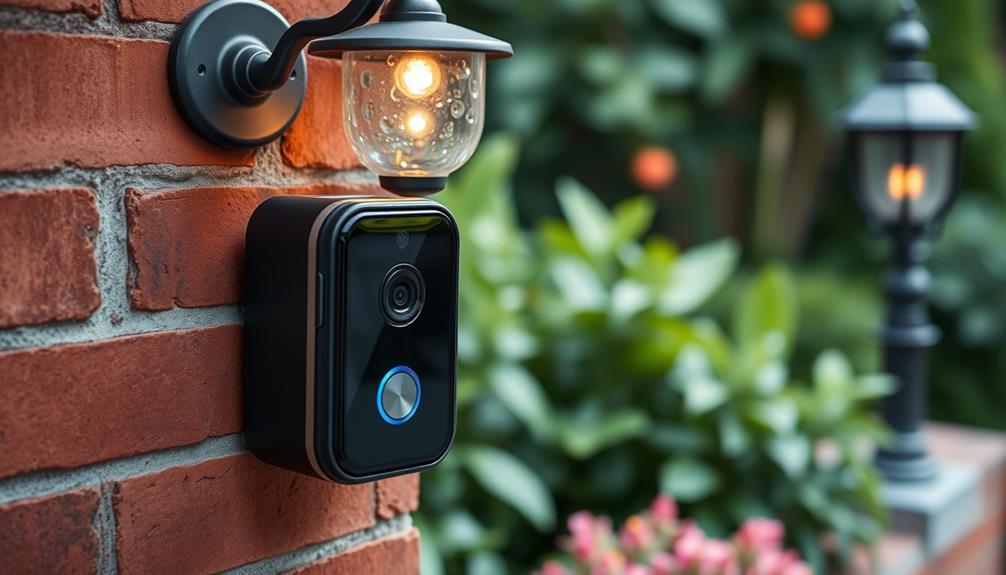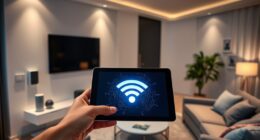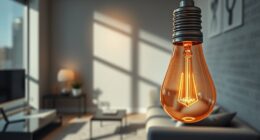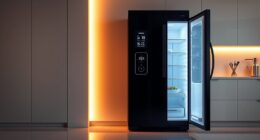For optimal outdoor security, it is recommended to position cameras at your front door, back and side doors, and along your driveway. Since nearly 34% of burglars enter through the front, this should be a top priority. Back and side doors also account for about 22% of break-ins. Placing cameras around 8 to 10 feet high helps eliminate blind spots, while wide-angle views enhance surveillance coverage. Don’t forget to include your garage, especially for nighttime monitoring, as over 70% of vehicle thefts occur in the dark. Interested in learning more tips to strengthen your security system? There is a wealth of information available to explore!
Key Takeaways
- Position cameras at least 4 feet above ground for optimal viewing angles to monitor entrances and activity around the property.
- Install cameras at back and side doors, as these are common entry points for intruders.
- Use wide-angle cameras (at least 130 degrees) to cover expansive areas, including yards, driveways, and multiple entry points.
- Ensure cameras have night vision capabilities to monitor activities effectively during low-light conditions, especially for vehicle protection.
Front Door Placement
Placing outdoor security cameras at your front door is essential since nearly 34% of burglars enter homes through this entry point. By installing security cameras, you can effectively monitor both package deliveries and visitor access, enhancing your home's security.
Consider using video doorbells, like the Blink's Outdoor 4, which serve as excellent primary or supplementary options to capture clear footage of anyone approaching your front entrance.
To maximize effectiveness, position your cameras around 4 feet above the ground and angle them outward. This setup optimizes the viewing angle and provides the best coverage of the area.
Ensuring your security cameras are visible acts as a strong deterrent against potential intruders; they're less likely to approach a home that clearly has surveillance in place.
Back and Side Doors
Back and side doors often serve as common entry points for intruders, making them essential spots for your security cameras.
By enhancing surveillance at these areas, you can better monitor potential risks and deter unauthorized access.
Positioning cameras strategically not only captures activity but also provides peace of mind.
Common Entry Point Risks
Many homeowners underestimate the risks associated with back and side doors, which are common entry points for burglars.
In fact, approximately 22% of burglaries occur through back doors, highlighting the need for proper surveillance in these areas.
Side doors, often hidden from view, can also be prime targets for intruders. This makes it essential to install security cameras at both back and side doors to monitor any suspicious activity.
Many people overlook securing these secondary entry points, leaving vulnerabilities that burglars can exploit.
Effective camera placement at these locations can greatly enhance your home's security awareness.
When cameras are visible, they act as a deterrent, reducing the likelihood of a break-in.
Research shows that intruders often avoid homes with obvious surveillance, knowing the risk of being recorded.
Enhanced Surveillance Strategy
An effective enhanced surveillance strategy focuses on securing your home's back and side doors, where intruders are more likely to attempt entry. Approximately 22% of break-ins occur through back doors, making it essential to install outdoor security cameras in these areas.
By positioning security cameras at both the back and side doors, you can monitor critical points of entry that often go unnoticed. Studies show that homes with security systems are markedly less likely to be targeted, as the presence of security systems deters 60% of potential burglars.
These entry points are frequently used by burglars, so having a surveillance system in place allows you to capture footage of any suspicious activity. Opt for cameras with a wide field of view to guarantee you can identify individuals approaching these less monitored areas. This proactive approach not only helps deter potential intruders but also enhances your overall home security.
Don't forget that enhancing surveillance at back and side doors complements the coverage provided by front door cameras. Together, these measures create a thorough monitoring system for your home. By prioritizing these locations, you greatly improve your chances of preventing break-ins and keeping your property safe.
Garage and Driveway

When it comes to securing your garage and driveway, identifying vulnerable entry points is essential.
Regular maintenance practices, such as ensuring proper lighting and checking for potential blind spots, can improve overall security.
You need to prioritize nighttime surveillance since most car thefts happen after dark.
Vulnerable Entry Points
Vulnerable entry points like garages and driveways require vigilant monitoring to deter potential break-ins and vehicle thefts. Installing security cameras in these areas is essential, especially since over 70% of car thefts occur at night.
You should focus on strategic camera placement around garage doors to provide expansive views of your driveway. This way, you can detect intruders early, before they access your garage filled with valuable tools and bikes.
Additionally, verifying that these areas are kept clean and free of clutter can enhance visibility and reduce hiding spots for potential intruders, making it easier to monitor the area effectively. For further safety, consider implementing strategies to stop the spread of aquatic nuisance species that may inadvertently come from outdoor equipment stored in your garage.
Outdoor security cameras need to have night vision capabilities to guarantee effective monitoring after dark. Pairing these cameras with floodlights or spotlights near the driveway can further enhance security by illuminating the area and deterring nighttime theft and vandalism.
Nighttime Surveillance Importance
Monitoring your garage and driveway at night is vital, especially since over 70% of car thefts happen after dark. Effective nighttime surveillance is fundamental for protecting your vehicles and belongings. By installing security cameras with night vision capabilities, you enhance your monitoring effectiveness, ensuring you can spot any suspicious activity around your property.
Additionally, using an ozone air purifier in your garage can help eliminate odors and allergens, contributing to a healthier environment while you monitor your space.
Consider these benefits of nighttime surveillance:
- Early detection: Positioning cameras at your garage and driveway allows for the early detection of intruders before they reach your home's entry points.
- Deterrence: Combining security cameras with floodlights or spotlights increases visibility, greatly reducing the likelihood of a break-in.
- Monitoring package deliveries: Thorough coverage also helps you keep an eye on package deliveries and visitors after hours, ensuring safety during nighttime interactions.
Investing in a well-placed security system for your garage and driveway is a proactive step toward safeguarding your property during the night.
Vehicle Protection Strategies
To effectively protect your vehicles, implementing a combination of security cameras and strategic lighting in your garage and driveway is essential.
Over 70% of car thefts occur at night when visibility is low, so installing weather-resistant security cameras with night vision capabilities is vital. According to best practices for home security, these cameras should be positioned at strategic angles to capture a wide field of view, allowing you to monitor your driveway effectively.
In addition to cameras, consider using floodlights or spotlights near your driveway. This strategic lighting acts as a deterrent to potential intruders and enhances the overall security of your property.
Wide Yard Views
Achieving wide yard views with your outdoor security cameras enhances your ability to spot activities around your property and keeps your home safer. To maximize your surveillance efforts, consider the following strategies:
- Position cameras to cover all entrances, including gates and shed doorways.
- Guarantee a field of view of at least 130 degrees to monitor larger areas effectively. Incorporating smart technology, like those found in <a target="_blank" href="https://dealsnbuy.com">top garage door openers</a>, can further enhance your overall home security system.
- Regularly check and adjust camera angles to eliminate any potential blind spots caused by trees or structures.
These wide yard views not only help you identify suspicious behavior but also act as a deterrent to potential intruders. By making your cameras visible, you signal that surveillance is active, which can discourage criminal activity.
Remember, proper placement is vital; don't let trees or other obstructions limit your camera's effectiveness. Regularly assess and adjust the positioning of your outdoor security cameras to guarantee they're always capturing the best possible angles.
With these measures in place, you'll enhance your home's security and enjoy peace of mind knowing your property is under vigilant watch.
Common Indoor Areas

Common indoor areas, like kitchens and living rooms, are ideal spots for placing security cameras to keep an eye on children and confirm the safety of babysitters. When you think about camera placement, consider positioning indoor cameras at a height of 8 to 10 feet. This maximizes coverage while minimizing the risk of tampering. Incorporating innovative design approaches in your home can also enhance the effectiveness of your security system, allowing for seamless integration of cameras into your living spaces tailored solutions for unique challenges.
In addition to monitoring children, placing cameras in rooms with large ground-floor windows enhances visibility and captures any suspicious activity. It's essential to make sure that your security cameras are strategically placed in these common areas to provide effective video surveillance without invading the privacy of family members.
To enhance security further, consider using privacy shields on your indoor cameras, especially in sensitive locations. This way, you respect the privacy of your loved ones while still maintaining a watchful eye on your home. Whether it's to monitor playtime or confirm a babysitter's safety, indoor cameras can be a valuable addition to your security system. By focusing on these common areas, you can create a safer environment for everyone in your home.
Main Stairway or Hallway
Placing security cameras in main stairways or hallways lets you monitor all movement within your home, effectively preventing unauthorized access to private areas like bedrooms and bathrooms.
Proper camera placement in these areas enhances indoor security by capturing changes between spaces, guaranteeing that you have a thorough view of your home. Additionally, utilizing testimonials from users who've successfully enhanced their home security with camera systems can serve as valuable social proof in your decision-making process.
Here are some key considerations for camera installation in stairways and hallways:
- Height: Install cameras at a height of 8 to 10 feet to obtain clear footage of individuals moving up or down the stairs.
- Angles: Position cameras away from direct light sources to avoid glare and guarantee high-quality recordings.
- Coverage: Strategically place cameras to cover multiple rooms and entry points, enhancing your overall home security.
Camera Features to Consider

When choosing outdoor security cameras, it's essential to take into account features like resolution, field of view, and weather resistance to guarantee effective monitoring of your property.
Start with resolution; opt for cameras with at least 1080p to assure clear and detailed video quality. This level of clarity helps you identify faces and license plates during critical moments. Additionally, understanding the importance of cybersecurity measures can further enhance the security of your home network, preventing unauthorized access to your camera feeds.
Next, consider the field of view. A wide field of view, ideally at least 130 degrees, allows you to cover larger areas of your property, minimizing blind spots. This feature is essential for thorough surveillance.
Don't overlook weather resistance, either. Look for outdoor cameras that come with an appropriate IP rating, such as IP65 or higher, so they can withstand rain, snow, and other harsh conditions.
Additionally, night vision capabilities are important. Cameras with infrared or color night vision will help you monitor your property effectively after dark.
Installation Best Practices
Selecting the right features for your outdoor security cameras sets the stage for effective surveillance, but proper installation is just as important for maximizing their performance. To achieve ideal coverage, consider these installation best practices:
- Height Matters: Position your cameras at least 8 to 10 feet high to deter tampering while maintaining a clear line of sight. Cats, for instance, may be deterred from areas with elevated cameras, which can help in monitoring your pets' activities in the yard.
- Strategic Placement: Install cameras in the corners of structures to maximize their field of view and eliminate blind spots. This is similar to how understanding your pet's <a target="_blank" href="https://aplaceforanimals.com">emotional connection</a> can enhance their safety and comfort in the home.
- Avoid Glare: Mount cameras away from direct sunlight to prevent glare that can degrade video quality. Protective covers can help as well.
After completing your security camera installation, regularly check the camera angles and positions. This maintains effective surveillance by adjusting for any obstructions or changes in the environment.
Legal Considerations for Cameras

Understanding the legal landscape surrounding outdoor security cameras is vital to confirm you're protecting both your property and the privacy rights of others.
First, be aware of the reasonable expectation of privacy; placing cameras in areas like bedrooms or bathrooms can lead to significant legal issues. Surveillance laws vary by state, so it's important to check local statutes regarding security camera placement to guarantee compliance.
Additionally, conducting thorough background checks can help assess potential risks associated with your security setup, confirming responsible use of surveillance technology.
The Kyllo vs. United States Supreme Court case highlights the importance of avoiding surveillance from public spaces that could infringe on private property rights. Make sure your cameras don't point towards neighboring properties, as this can violate privacy rights and lead to disputes.
To navigate these legal considerations effectively, consulting with a legal professional can provide clarity on the specific laws and regulations in your area. They can help you understand how to install and use security cameras without running afoul of the law.
Frequently Asked Questions
Where Should Outdoor Security Cameras Be Placed?
When determining where to place outdoor security cameras, you should focus on high-risk entry points. This includes areas such as entrances, windows, and any other vulnerable spots that can be potential targets for intruders. Additionally, it’s also important to consider the range and field of view of the outdoor security cameras to ensure they can effectively monitor these high-risk entry points. If you’re also considering enhancing your home security, you may want to look into ring doorbell installation for added functionality and peace of mind. This can provide not only surveillance capabilities, but also the convenience of being able to see and communicate with visitors at your front door, whether you’re at home or away.
Position them above ground-level doors and windows, especially the front door, as it's a common entry for burglars.
Don't forget back and side doors, as well as your driveway and garage, to protect vehicles.
Aim to mount cameras 8 to 10 feet high for ideal coverage, angling them down to avoid glare and enhance video clarity.
Where Not to Install Security Cameras?
Imagine trying to take a photo of a beautiful sunset but facing a wall instead; you'd miss the view entirely.
When installing security cameras, don't place them directly facing windows, as glare can ruin footage.
Avoid low placements that invite tampering, obstructed areas where visibility is compromised, and direct sunlight that distorts images.
Also, steer clear of private spaces, respecting privacy laws and ethical concerns.
Your camera's effectiveness hinges on these choices!
How High Should an Outdoor Security Camera Be?
When installing an outdoor security camera, you should mount it between 8 to 10 feet high. This height optimizes the camera's field of view and makes it harder for intruders to tamper with.
Avoid placing it below 12 feet to guarantee clear image quality and facial recognition.
Angle the camera slightly downward for a broader view, and make certain it's not facing bright lights to prevent glare.
Adjust based on your specific location for the best coverage.
How Many Security Cameras Do I Need Outside My House?
Imagine stepping outside, feeling secure as your home stands guard.
You'll want at least three security cameras to create a protective shield around your property.
One should watch your front door, another the back, and the third can keep an eye on side entrances.
This setup helps guarantee you're covered from all angles, deterring potential intruders while giving you peace of mind, knowing you've taken steps to protect your space.
Conclusion
Just like a vigilant knight guarding a castle, placing your outdoor security cameras wisely creates a protective shield around your home.
By securing key entry points and monitoring wide views, you're not just watching over your property; you're ensuring peace of mind for you and your family.
Remember, every castle needs its watchtowers—so choose your camera locations wisely, and you'll sleep soundly, knowing you've built a strong defense against unwanted intruders.









